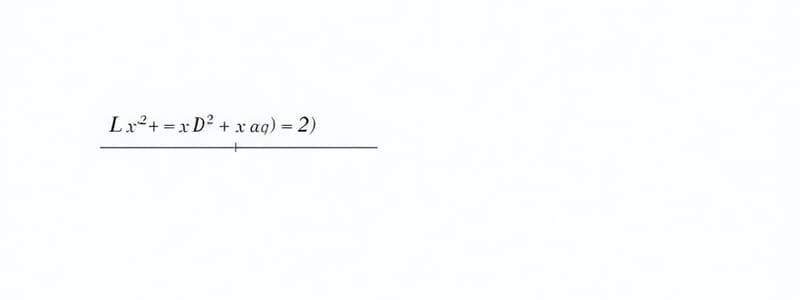Podcast
Questions and Answers
Which of the following is NOT a requirement for a function to be continuous at a point c?
Which of the following is NOT a requirement for a function to be continuous at a point c?
- The limit of the function as x approaches c must equal f(c)
- The function must be differentiable at c (correct)
- The function value f(c) must be finite
- The limit of the function as x approaches c must exist
What is an example of a jump discontinuity?
What is an example of a jump discontinuity?
- A function defined at c with a hole at c
- A function that has vertical asymptotes
- A piecewise function with different values for adjacent intervals (correct)
- A function that oscillates infinitely near c
Which type of continuity ensures that a function behaves consistently across its entire domain?
Which type of continuity ensures that a function behaves consistently across its entire domain?
- Global Continuity (correct)
- Piecewise Continuity
- Absolute Continuity
- Uniform Continuity
How does the Intermediate Value Theorem (IVT) apply to continuous functions?
How does the Intermediate Value Theorem (IVT) apply to continuous functions?
Which of the following types of discontinuity can be corrected by defining the function differently at a certain point?
Which of the following types of discontinuity can be corrected by defining the function differently at a certain point?
Flashcards are hidden until you start studying
Study Notes
Continuity in Calculus
- A function ( f(x) ) is continuous at a point ( c ) if:
- ( f(c) ) is defined.
- ( \lim_{x \to c} f(x) ) exists.
- ( \lim_{x \to c} f(x) = f(c) ).
Applications of Continuity
- Used in determining limits and integrals.
- Fundamental in the Intermediate Value Theorem (IVT): If ( f ) is continuous on ([a, b]) and ( N ) is between ( f(a) ) and ( f(b) ), then there exists at least one ( c \in [a, b] ) such that ( f(c) = N ).
- Essential in optimization problems to ensure function behavior.
Elements of Continuity
- Point of Continuity: A specific point where the function is continuous.
- Interval of Continuity: Range of ( x ) values where the function remains continuous.
- Absolute Continuity: A stronger form where the function can be expressed as an integral of its derivative.
Types of Continuity
- Continuous at a Point: As defined above.
- Uniform Continuity: A function ( f ) is uniformly continuous on ( [a, b] ) if for every ( \epsilon > 0 ), there exists a ( \delta > 0 ) such that for all ( x, y \in [a, b] ):
- If ( |x - y| < \delta ), then ( |f(x) - f(y)| < \epsilon ).
- Global Continuity: Function is continuous over its entire domain.
- Piecewise Continuity: Function defined by multiple sub-functions, each continuous on its interval.
Discontinuities
- Types of discontinuities include:
- Removable Discontinuity: Exists where a function can be made continuous by redefining it at a point.
- Jump Discontinuity: Sudden change in function value; limits from the left and right do not equal.
- Infinite Discontinuity: Function approaches infinity at certain points; vertical asymptotes.
- Essential Discontinuity: Irregular behavior not fitting the previous types, often exhibiting chaotic behavior.
Continuity in Calculus
- A function ( f(x) ) is continuous at a point ( c ) if:
- ( f(c) ) is defined.
- The limit ( \lim_{x \to c} f(x) ) exists.
- The limit ( \lim_{x \to c} f(x) ) equals ( f(c) ).
Applications of Continuity
- Continuity aids in determining limits and integrals, leading to understanding behavior of functions.
- Fundamental in the Intermediate Value Theorem (IVT): If ( f ) is continuous on ([a, b]) and ( N ) lies between ( f(a) ) and ( f(b) ), then there exists at least one point ( c \in [a, b] ) such that ( f(c) = N ).
- Critical for optimization problems to guarantee predictable function behavior.
Elements of Continuity
- Point of Continuity: Specific locations where a function maintains continuity.
- Interval of Continuity: Range of ( x ) values across which the function is continuous.
- Absolute Continuity: A heightened type of continuity where the function can be written as an integral of its derivative, indicating a strong relationship between a function and its rates of change.
Types of Continuity
- Continuous at a Point: Defined by the criteria for continuity at a specific point.
- Uniform Continuity: A function ( f ) is uniformly continuous on ( [a, b] ) if for every ( \epsilon > 0 ), there exists a ( \delta > 0 ) such that for all ( x, y \in [a, b] ):
- If ( |x - y| < \delta ), then ( |f(x) - f(y)| < \epsilon ).
- Global Continuity: Means that the function is continuous across its entire domain without interruption.
- Piecewise Continuity: Functions can consist of multiple sub-functions that are individually continuous on specified intervals.
Discontinuities
- Removable Discontinuity: Characterized by the potential to redefine the function at a point to achieve continuity.
- Jump Discontinuity: Features a sudden change in function value where left and right limits do not converge.
- Infinite Discontinuity: Occurs when a function approaches infinity at specific points, typically represented by vertical asymptotes.
- Essential Discontinuity: Encompasses irregular behavior that does not conform to earlier categories, often leading to chaotic fluctuations in function values.
Studying That Suits You
Use AI to generate personalized quizzes and flashcards to suit your learning preferences.




